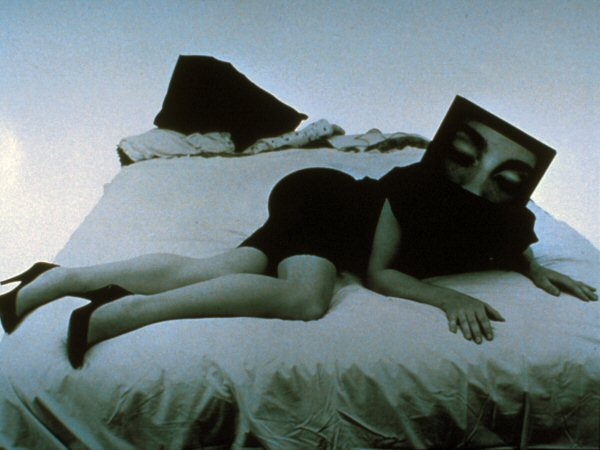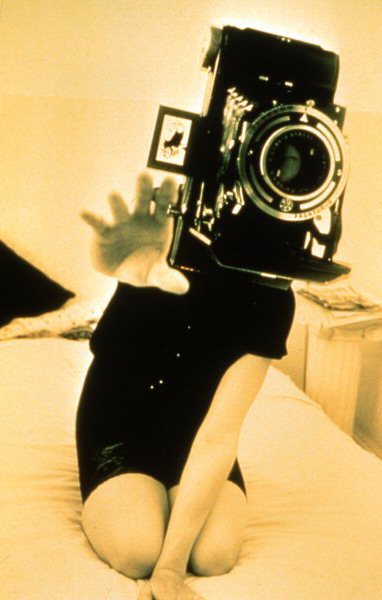Lynn Hershman
(San Francisco, California, United-States)
In 1973, with Eleanor Coppola, she created one of the first-ever installations outside a gallery setting, The Dante Hotel, for which each artist rented a hotel room which they furnished with a miscellany of objects. The objects in Hershman's room evoked traces left by previous occupants and by visitors, who could re-create fragments of fictional lives. Here Hershman was interested in the multiple strata of life contained by a place or site in a given socioeconomic environment. From then on, her work was characterized by such elements as the use of masks and personae to explore "identity, reality and truth." (1) As early as 1972, a work titled Self-Portrait as Another Person revealed her interests in masquerade and in the persona, so central to her work.
In the 1970s, specifically from 1973 to 1978, Roberta Breitmore was her major creation. Roberta Breitmore is a persona Hershman adopted over several years, enacting the transformation with wigs, make-up and clothing. With the addition of a little bureaucratic validation (driver's licence, credit cards, address and bank account, psychological profile, etc.), the fictional character became practically real, spilling over from fiction into reality. Today nothing remains to indicate her existence apart from a few artifacts: diary, letters, photographs and diverse documents. The work itself consisted essentially of Roberta's experiences. One of these was her very real encounter in a park with a man answering a classified ad she had placed in order to find a roommate. Roberta found herself surrounded by three men who were linked with a prostitution ring; she escaped their clutches by fleeing into a public toilet and removing her disguise. Roberta Breitmore let Hershman highlight several feminist problematics, such as the way the social and cultural environment constructs women's identities, and how women are victims of the structures and conditioning imposed on them. In 1978, rather than committing suicide (as the artist had planned), Roberta ended her days during an exorcism at the grave of Lucrezia Borgia in Ferrara, Italy. Lynn Gumpert and Ned Rifkin, curators of the exhibition Persona at The New Museum in New York, commented on Roberta Breitmore's finale :
"The final performance evokes Roberta's alchemical origins as it deals with a double, a transformation through fire, and a rebirth from ashes. It also signifies the transformation of Roberta from passive to active, and, as Hershman had hoped, from victim to victor." (2)
It wasn't until the late 1970s that Hershman started to work in the video medium, which she would then use to further her exploration of similar problematics and themes: the relationship of identity with social and cultural structures as well as with the media environment; the powerlessness of the female subject in these contexts; and the process by which personal power can emerge, using criticism as well as the media. Since the beginning of the 1980s, she has made about 30 videos of all types. The 1992 exhibition Video and Orality, (3) at the National Gallery of Canada (NGC) presented three parts of Electronic Diary - Confessions of a Chameleon (1986), Binge (1987) and First Person Plural (1989) - and also Longshot (1989). These works illustrate her use of the medium for purposes of self-examination, her adoption of persona, and above all her handling of the voice as a marker of doubtful authenticity in the mediatized expression of self. In 1995, the NGC also mounted a major retrospective, Lynn Hershman: Virtuellement Vôtre, (4) where seven other titles were shown, including Virtual Love (1993), a coproduction with German television, and Shooting Script (1992), a coproduction with the Danish Film Workshop.
In 1979, Hershman began creating one of the first interactive videodisk artworks. Entitled Lorna (1979-1983), it shows a woman suffering from agoraphobia who shuts herself away at home. Here we find echoes of the room in The Dante Hotel as well as reminders of Roberta Breitmore. In 1984, she created a second videodisk, Deep Contact: The Sexual Fantasy Videodisk (1984-1989). Room of One's Own (Une chambre à soi) (1990-1993) is her third interactive work, first created in 1990 and refined - in terms of design and the computer program controlling the piece - until 1993. That year, she undertook the production of America's Finest (1993-1995) which enacted the idea of Étienne Jules Marey's camera-gun, already implicit in Room of One's Own. Finally, a commission from the Seattle Art Museum allowed her to create Paranoid Mirror (1995-1996). In these interactive works, Hershman is less interested in the construction of female persona in a media society than in how the spectator's gaze is enmeshed in such constructions through mechanisms that the artist uses and puts in place to reveal these very regimes and forms of the gaze. All these systems include the gaze of whoever is looking and turn it back on itself, reverse it, so that the mechanism addresses itself to the looker, the eyes of one meeting the eyes of the other. Hershman then returned to the creation of characters, this time with Conceiving Ada her first feature film on the work and life of Ada Byron King, Countess of Lovelace (1815-1852), an amateur mathematician who is credited with the creation of the first programming language and who predicted its use in music, poetry and art. As Kathy Rae Huffman and Margarete Jahrman emphasize :
"In Conceiving Ada, Hershman demonstrates originality and astuteness, but never disregards her feminist mission to explore female communication practices, insight and sexuality. In previous works of Hershman, her characters were named Lorna, Roberta, Marion or Chystene, but each female character looked the viewer directly in the eye and validated her credibility. Ada and Emmy Core (Francesca Faridany), her 20th Century counterpart, also 'connect' and 'communicate', visually, spiritually and professionally." (5)
Since 1995, Hershman has created telerobotic pieces and experimented with works that use both in situ and Internet elements: Difference Engine # 3 was shown in 1998 at the Media Museum of the Zentrum für Kunst und Medientechnologie (ZKM), and Time and Time Again was presented in 1999 by the Wilhelm Lehmbruck Museum in Duisburg am Rhein, Germany, as part of an exhibition entitled Connected Cities: Processes of Art in the Urban Network.
Finally, let's mention Hershman's latest film Teknolust (2002). In it, Tilda Swinton plays the role of a bio-geneticist who uses her own DNA to create three SRAs or Self Replicating Automatons: Ruby, Marine and Olive. All four roles are played by the British actress. Ruby becomes Agent Ruby in the work bearing her name. The film presents characters who seek love in a world where sexuality is fast becoming an outmoded means of reproduction, an increasingly virtual world where only love is real. Teknolust is a romantic comedy in its truest sense - complete with happy ending.
From November 5, 2005, to April 30, 2006, The Henry Art Gallery of Seattle (Washington, United States) presented a major international museum retrospective of her work. The exhibition will travel to the ZKM Media Museum (Karlsruhe, Germany). In 2005, the University of California Press released Secret Agent, Private I, The Art and Film of Lynn Hershman Leeson.
Hershman Leeson is an Emeritus Professor of Digital Art in the Techno Cultural Studies Program at the University of California, Davis, and an A.D. White Professor at Large at Cornell University, the highest honour bestowed by that institution.
Seven works by Lynn Hershman were shown at the Montreal Museum of Fine Arts from September 20 to December 9, 2007, for the exhibition e-art: New Technologies and Contemporary Art, Ten Years of Accomplishments by the Daniel Langlois Foundation.
Jean Gagnon © 2006 FDL
(1) Moira, Roth and Diana, Taini in "Interview With Lynn Hershman" in Lynn Hersman, Chimaera monographie no. 4 (Montbéliard Belfort, France : Éditions du Centre international de création vidéo, 1992); p. 108.
(2) Persona, exhibition catalogue (New York: The New Museum, 1981), p. 15.
(3) Video and orality, Musée des beaux-arts du Canada, Ottawa, Ont., Canada, 10 décembre 1992-28 février 1993. - Commissaire : Jean Gagnon. - Catalogue.
(4) Lynn Hershman Virtually yours = Lynn Hershman, Musée des beaux-arts du Canada, Ottawa, Ont., Canada, 4 mai-3 juillet 1995. Commissaire : Jean Gagnon. Catalogue.
(5) This text offers an excellent presentation of the project and of the film that emerged from it. http://www.heise.de/tp/english/pop/topic_2/4102/1.html
Related pages:
 Lynn Hershman, Agent Ruby
Lynn Hershman, Agent RubyLynn Hershman has examined the complex conditions at the core of emerging subjectivity since the 1970s.
 Lynn Hershman, Life to the Second Power: Animating the Archive
Lynn Hershman, Life to the Second Power: Animating the ArchiveLife to the Second Power aims to turn the archive of Lynn Hershman Leeson into a new mixed reality and dynamic experience.
 Lynn Hershman, Room of One's Own
Lynn Hershman, Room of One's OwnRoom of one's own, which makes clear reference to the book by Virginia Woolf, is designed as a peep show.
 e-art: New Technologies and Contemporary Art
e-art: New Technologies and Contemporary ArtTo mark the tenth anniversary of the DLF, the MMFA has presented works by ten artists who have received funding from the DLF over the years.
External links:
http://www.aec.at/
http://www.lynnhershman.com
















